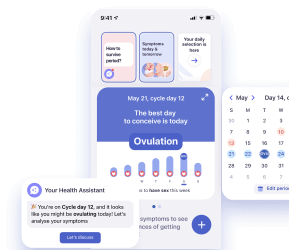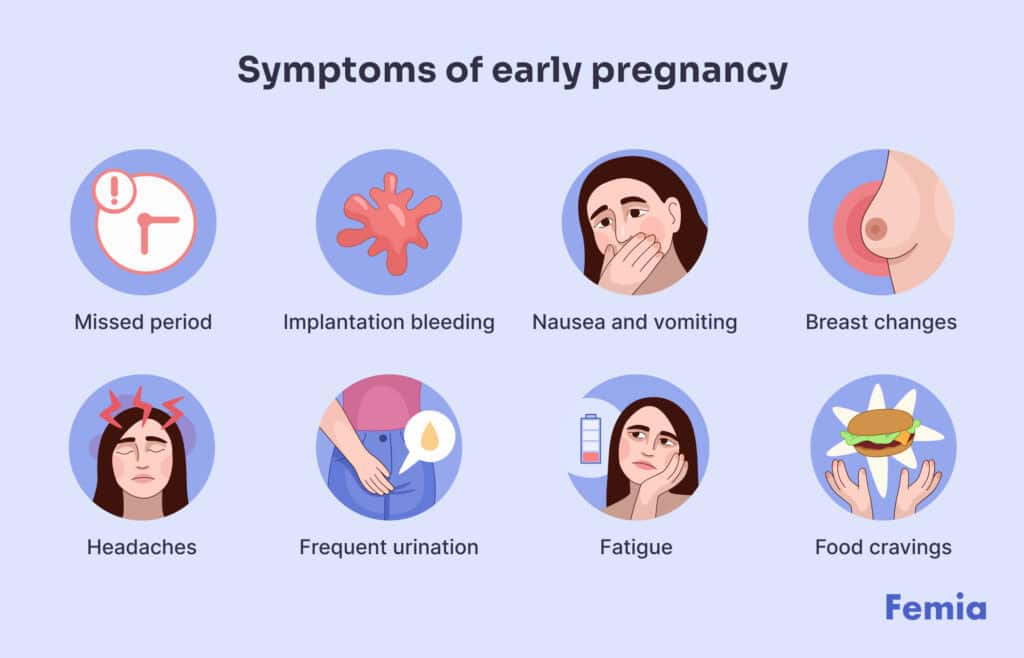Femia > Health Library > Getting Pregnant > Trying to conceive > Discharge before period vs early pregnancy: How to tell the difference
Discharge before period vs early pregnancy: How to tell the difference

- Updated Mar 2, 2025
- Published
CRAFTED BY HUMAN
Crafted by human At Femia, we provide accurate and up-to-date information at every stage of your journey, from trying to conceive, pregnancy and postnatal support. All content is created by a real person based on in-depth research and own professional experience. Femia ensures that you will receive expert advice, strict accuracy and a personalized approach from our authors/medical experts. Learn more about our editorial policy.
FACT CHECKED
Fact checked At Femia Health, we maintain the highest standards of editorial excellence in delivering content focused on helping you conceive, guiding you through pregnancy, and supporting you postpartum. Explore our content review principles to learn how we ensure the accuracy and quality of our health and lifestyle tips for every stage of your journey.
Vaginal discharge is a normal occurrence in the female body that reacts to hormonal fluctuations and other stimuli by changing its amount, consistency, and color. Noticing some discharge before your period is normal and often a natural premenstrual symptom, though sometimes it might indicate pregnancy.
There are four primary factors distinguishing discharge before period vs early pregnancy:
- Color: Milky or white before the period, whilst pregnancy discharge is clearer.
- Consistency: Dry and sticky before period, whilst thinner and more abundant in early pregnancy.
- Timing: Pregnancy discharge begins after conception and lasts beyond the expected period, whereas pre-period discharge occurs in the luteal phase.
- Additional symptoms: When white discharge is just a normal premenstrual symptom, it’s often accompanied by PMS symptoms, whereas pregnancy discharge might be accompanied by other early pregnancy signs.
Vaginal discharge is a normal occurrence for most girls and women. It’s a fluid or mucus that helps maintain vaginal health by keeping it clean and moist. You’ll likely notice that your vaginal discharge changes its amount, consistency, and color from time to time. These changes are most frequently influenced by hormonal changes and thus can give you clues about where you currently are in your menstrual cycle. At the same time, changes in your mucus can indicate more fundamental changes going on in your body, such as pregnancy.
In this article, we’re going to take a comparative look at discharge before period vs early pregnancy. We’ll cover the primary characteristics and distinct features of these two types of discharge to help you understand your body’s signs better. Also, we will suggest when to consult a doctor.

What is vaginal discharge, and why does it occur?
Vaginal discharge is a mixture of liquid, cells, and bacteria that sheds from your vagina throughout the day. It’s an absolutely natural occurrence that performs a number of critical functions, including lubrication, protection against infections, and cleansing. All in all, the primary purpose of discharge is to maintain vaginal health.
The connection between vaginal discharge and hormones
Vaginal discharge is made by the fluid coming from the glands in and around the cervix and the cells lining the vagina and cervix. The female hormone, estrogen, influences the function of the glands and the lining, which in turn impacts vaginal discharge.
When estrogen is low, at the start of the cycle, your mucus should typically appear as dry or pasty. Then, it gradually becomes creamier as the level of estrogen rises and becomes wet, stretchy, and slippery around the time of your ovulation when the level of estrogen peaks. This slippery mucus, which resembles raw egg whites, performs another crucial function – making it easier for sperm to swim into the uterus and fertilize an egg.
Estrogen and pregnancy discharge
Similarly to how your hormones fluctuate naturally throughout the cycle, they undergo major shifts during pregnancy. After the egg is fertilized in ovulation, the level of estrogen does not decrease (as usually happens after ovulation) but instead rises, to support fetal development. This typically leads to an increase in vaginal discharge.
Increased pregnancy discharge is there to protect the fetus from external infections. Typically, its amount continues rising up until delivery.
👉Find out more: First-trimester screening: Understanding genetic testing and results during early pregnancy
Discharge before period: What to expect
To be able to tell the difference between period discharge vs pregnancy discharge, you need to understand the main characteristics of each.
So what does discharge look like before period? Typically, it can be distinguished based on the following characteristics:
- Creamy or white
- Thick and less stretchy compared to wet and slippery ovulation discharge
These changes occur due to the level of progesterone, which naturally rises before your period. Also, due to the lowering of estrogen, the amount of discharge before period may be minimal. Additionally, you may notice premenstrual syndrome (PMS) symptoms, such as mood swings, bloating, breast tenderness, etc.
Early pregnancy discharge: What it looks like
If you want to be able to recognize pregnancy discharge before missed period, the key signs to look out for include:
- Thin and odorless discharge
- Milky white color
- Greater volume
These characteristics of early pregnancy discharge are a result of the rising estrogen needed to support fetal development. This discharge can be noticed shortly after ovulation (conception), at a time when your mucus would typically be less abundant, and would typically be cloudier and stickier due to the lowering of estrogen and rising of progesterone.
Key differences between discharge before period vs early pregnancy
There are four main factors that can help you tell whether what you’re experiencing is discharge PMS or pregnancy:
| Discharge before period | Early pregnancy discharge | |
|---|---|---|
| Timing | Pre-period discharge takes place in the luteal phase of your cycle when estrogen lowers and progesterone increases. | Pregnancy discharge shows right after ovulation when conception takes place. |
| Consistency | Pre-period discharge is typically dry or pasty due to progesterone. It also often comes in a very minimal amount. | Increasing estrogen in early pregnancy makes vaginal discharge thinner and more abundant than your typical pre-period mucus. |
| Color | Cloudy, milky, and white. | Also cloudy, milky, and white. However, in early pregnancy, discharge tends to have a clearer appearance. |
| Accompanying symptoms | Period discharge is frequently accompanied by PMS symptoms, including mood swings, tender breasts, bloating, etc. | Early pregnancy discharge might be accompanied by other early pregnancy signs, such as breast tenderness, nausea, and fatigue. |
White discharge before period: Is it a sign of pregnancy?
If you have been trying to conceive, it’s natural to look out for any early signs that can confirm the awaited pregnancy. So when you notice a specific discharge, it’s absolutely normal to wonder if it means something.
So is white discharge before period sign of pregnancy? – It might be. As you already know, cloudy, milky, and white vaginal discharge with a clearer appearance might be one of the signs of early pregnancy. Yet, it’s not a definitive sign.

In order to confirm pregnancy with more accuracy, it’s recommended to look for other symptoms such as:
- Missed period
- Implantation bleeding
- Nausea and vomiting
- Breast changes, such as swelling and tenderness
- Headaches
- Frequent urination
- Fatigue
- Food cravings
👉Find out more: Implantation cramps: What they feel like, when they occur, and how long they last
Watery discharge before period sign of pregnancy
While the white color of your discharge is typical both for early pregnancy and in the days leading up to your period, an increase in volume and a thinner, watery discharge consistency might be a sign of pregnancy. A higher volume and watery consistency come from the rising estrogen, which is needed to help support the thickening of the uterine lining and prepare for pregnancy.

Discharge PMS or pregnancy: How to know the difference
So you’ve noticed certain changes in your vaginal discharge. Now, how do you tell for sure whether it’s pre-period discharge vs pregnancy discharge?
Let’s briefly compare these two:
- PMS: If you track the natural cervical mucus stages, you will see that discharge before period is usually thick, sticky, or tacky. It’s not abundant and is often accompanied by cramps, mood swings, and other PMS symptoms.
- Pregnancy: In early pregnancy, you can notice an abundant, watery discharge. This can be accompanied by other early pregnancy signs like fatigue, nausea, implantation cramps, spotting, etc.
These signs can help you distinguish between the signs of period vs pregnancy discharge. Yet, the best way to tell for sure whether you’re pregnant or not is to look out for additional symptoms and take a test when it’s time.
When to consult a doctor
Vaginal discharge is a normal occurrence that signals normal hormonal fluctuations during different phases of your cycle or pregnancy. However, in some cases, it might signal underlying health issues and require a consultation with a doctor.
Generally, it’s recommended to see a healthcare provider if your discharge is:
- Yellow, green, or foul-smelling. These might be the signs of infection.
- White and very thick, similar to cottage cheese. Such discharge might indicate a thrush.
- Pink after sex or at other times outside of your period.
- Accompanied with other negative symptoms, such as itching, burning, pain, etc.
Outside of noticing an atypical color, odor, consistency, or accompanying symptoms, it’s also recommended to consult a doctor if you recognize early pregnancy discharge. If you already suspect that you’re pregnant, receiving proper early prenatal care can help you confirm the pregnancy early, support its healthy development, and manage any risks that may arise.
Questions from the Femia community
Can early pregnancy discharge look like pre-period discharge?
Yes, pregnancy discharge before missed period can resemble your regular pre-period discharge by its creamy and white appearance. Yet, pregnancy discharge is often thinner, more abundant, and remains beyond the expected period.
What does implantation discharge look like?
Implantation typically takes place 1-2 weeks after conception. During it, a fertilized egg attaches to the uterus lining, sometimes, damaging it and causing implantation bleeding. Such implantation discharge is usually pink or brown-colored spotting that's lighter and shorter than your period.
Can discharge alone confirm pregnancy?
No. Although it could be one of the early signs, it shouldn’t be treated as a definitive sign on its own. To confirm pregnancy, you should look out for additional early symptoms and take a pregnancy test when it’s time.
Can discharge before a period vary from cycle to cycle?
Yes, your vaginal discharge, including its color, consistency, and amount is dynamic and can change through different stages of your cycle. It’s primarily affected by your hormone levels. Additionally, it can change due to lifestyle changes or stress.
The bottom line
Vaginal discharge is a natural occurrence that can naturally change during different stages of your menstrual cycle. Yet, sometimes, a certain appearance of pregnancy discharge before missed period can be an early sign indicating conception, though it may be difficult to distinguish from your typical pre-period discharge.
What color is early pregnancy discharge? – Typically, it’s cloudy, milky, and white, which is the same color as a typical discharge before period. However, early pregnancy discharge is typically more abundant and clearer, whereas pre-period discharge is often dry or pasty and not abundant.
Other factors that can help distinguish pregnancy discharge vs period discharge include:
- Timing: Pre-period discharge occurs in the cycle’s luteal phase, whereas pregnancy discharge takes place right after ovulation and extends beyond your expected period.
- Additional symptoms: Pre-period discharge is often accompanied by PMS symptoms, whereas pregnancy discharge might come along with other early pregnancy signs, such as breast tenderness, nausea, etc.
Now, you should have a better idea of how to tell the difference between early pregnancy discharge vs period discharge. By paying attention to these distinct features you’ll be better able to recognize your body’s signals. Don’t hesitate to consult a healthcare provider if you suspect that you’re pregnant or if you notice an unusual discharge.
References
- “Vaginal discharge.” Mayo Clinic, 25, Apr. 2023. https://www.mayoclinic.org/symptoms/vaginal-discharge/basics/definition/sym-20050825#.
- Reshef Tal, Hugh S. Taylor. “Endocrinology of Pregnancy.” Endotext [Internet], 18, Mar, 2021. https://www.ncbi.nlm.nih.gov/books/NBK278962/.
- “Premenstrual syndrome (PMS).” Mayo Clinic, 25, Feb. 2022. https://www.mayoclinic.org/diseases-conditions/premenstrual-syndrome/symptoms-causes/syc-20376780#.
- “What is prenatal care and why is it important?” Eunice Kennedy Shriver National Institute of Child Health and Human Development, 31, Jan. 2017. https://www.nichd.nih.gov/health/topics/pregnancy/conditioninfo/prenatal-care.
- “Implantation Bleeding.” Cleveland Clinic, 9, Aug. 2024. https://my.clevelandclinic.org/health/symptoms/24536-implantation-bleeding.

Learn the ultimate guide to female orgasm with the orgasm tips, tricks, techniques, and do’s and don’ts to achieve the most satisfying sex experience!

Learn effective self-care tips for managing endometriosis symptoms and optimizing fertility. Discover how diet, exercise, and stress management can improve your quality of life.

Discover natural ways to boost estrogen levels. Learn about dietary changes, supplements, and lifestyle habits that can help balance hormones. Expert advice from Femia.

